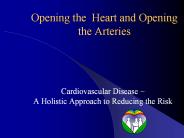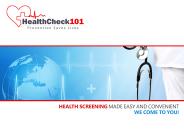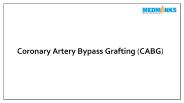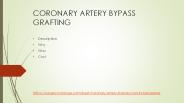Arteries PowerPoint PPT Presentations
All Time
Recommended
Arteries Veins and Capillaries Fig. 20.2 Arteriosclerosis age atherosclerosis Arteriosclerosis age atherosclerosis from Fawcett, Histology Arterial Walls Stained for ...
| PowerPoint PPT presentation | free to view
Learn about the early warning signs of clogged arteries and heart disease prevention techniques. Consult Dr. Gokhale, best cardiologist in Hyderabad.
| PowerPoint PPT presentation | free to download
Arteries meaning windpipe, artery” are blood vessels that carry blood away from the heart. While most arteries carry oxygenated blood, there are two exceptions to this, the pulmonary and the umbilical arteries.Here are the natural ways to clear arteries know more by visiting www.Plus100years.com
| PowerPoint PPT presentation | free to download
Myocardial infarction with non-obstructive coronary arteries
| PowerPoint PPT presentation | free to download
Arteries, Arterioles, Veins, Venules, & Capillaries Arteries Large hose-like vessels Carry blood away from the heart. Have thick, multi-layered muscular walls.
| PowerPoint PPT presentation | free to download
AORTA AND PERIPHERAL ARTERIES ANATOMY & VISUALIZATION Presented By; Dr Rakesh Jain Radial Artery Continuation of the brachial Smaller in caliber than ulnar.
| PowerPoint PPT presentation | free to view
Arcuate artery. Metatarsal arteries. Internal iliac artery. Superior gluteal artery ... Veins of the Upper Limbs and Thorax. Figure 19.27b. Right subclavian ...
| PowerPoint PPT presentation | free to view
Arial Wingdings Calibri Ripple 1_Ripple Main Arteries and Veins of Neck Common Carotid Artery Slide 3 Carotid Sinus Carotid Body Common Carotid Artery Relations ...
| PowerPoint PPT presentation | free to view
Peripheral Arterial Disease (PVD) deals with the problems of arteries (blood vessels carrying oxygenated blood) of the body excluding heart and brain. With India labelled as the diabetic capital of the world and with the highest number of Cardio-Vascular diseases, the Vascular Department has become an integral part of any Super Speciality Hospital.
| PowerPoint PPT presentation | free to download
Opening the Heart and Opening the Arteries Cardiovascular Disease A Holistic Approach to Reducing the Risk The typical talk on this subject: Cardiovascular ...
| PowerPoint PPT presentation | free to download
The functions of the arteries are discussed in detail in this article. All of your body parts and tissues get oxygenated blood via blood vessels.
| PowerPoint PPT presentation | free to download
MR Imaging of Atherosclerosis in Human Carotid Arteries. University of Washington. Chun ... Kang et al. MRM, 44:968-972, 2000. MRI of Atherosclerosis: Appearance ...
| PowerPoint PPT presentation | free to view
MR Imaging of Atherosclerosis in Human Carotid Arteries. University ... Mallory's Trichrome. 10x. Inset (90 rotation) 25X. Yuan C, et al. JMRI, 15:62-67, 2002 ...
| PowerPoint PPT presentation | free to view
ANOMALIES OF THE GREAT ARTERIES AND THE SUBSYSTEM. ANOMALIES OF THE GREAT ARTERIES ... RIGHT AORTIC ARCH WITH MIRROR-IMAGE PATTERN OF SUPRAAORTIC ARTERIAL BRANCHES ...
| PowerPoint PPT presentation | free to view
Arterial switch with or without VSD closure. Senning. Mustard. Rastelli. REV. TGA , other procedure. Allowable Concomitant Diagnoses: ...
| PowerPoint PPT presentation | free to view
Arteries, veins, and capillaries transport blood to all parts of the body. Arteries carry blood away from the heart. blood under great pressure thicker, more muscular ...
| PowerPoint PPT presentation | free to download
Adventitia (external boundary of the arterial wall) is opaque due to ... grant using the results of the IBIS-funded study to support the feasibility of ...
| PowerPoint PPT presentation | free to view
Systolic pressure measures blood pressure as the heart contracts and pushes blood through the arteries. Diastolic pressure is taken when the heart relaxes. Normal blood pressure is around 120/80 or lower.
| PowerPoint PPT presentation | free to download
Reckeweg-India offers you to buy genuine Dr. Reckeweg R3 homeopathic medicine for cleaning arteries online in India at the best price. To know more visit at https://www.reckeweg-india.com/product-details/R3-3.html
In neonates with tricuspid atresia and normally related great arteries we sought ... Tricuspid atresia with concordant AV and VA connections. Diagnosed within ...
| PowerPoint PPT presentation | free to view
GUSTO IV-ACS Global Use of Strategies To Open Occluded Coronary Arteries IV-Acute Coronary Syndrome * * GUSTO-IV ACS: Objective To determine the effect of upstream ...
| PowerPoint PPT presentation | free to view
Characterisation of the time course of the superior mesenteric, aorta and internal carotid arteries
| PowerPoint PPT presentation | free to view
Which of the following is a pressure wave created by the expansion and recoiling of arteries? A) Circulation B) Pulse C) Blood flow D) Blood pressure
| PowerPoint PPT presentation | free to view
Peripheral Artery Disease (PAD) is a common circulatory problem where narrowed arteries reduce blood flow to the limbs.
| PowerPoint PPT presentation | free to download
The carotid arteries are the two large arteries, which supply the oxygenated blood to the brain. They can be felt one on each side of the neck immediately below the jaw angle.
| PowerPoint PPT presentation | free to download
Coronary Artery Disease is a condition which affects the arteries that supply blood to the heart.
| PowerPoint PPT presentation | free to download
Peripheral arterial disease, or PAD, is a form of arterial disease appearing outside of the brain and heart. In patients suffering from PAD, the arteries carrying oxygenated blood in the body tend to get narrowed or blocked. The narrowing or blocking of arteries stems from plaque or atherosclerosis. Generally, PAD impacts the arteries in the legs. However, it can also extend to affect the arteries carrying blood to the kidneys, gastrointestinal tract, the head, and arms.
| PowerPoint PPT presentation | free to download
Peripheral artery disease, known as (PAD), is a narrowing of the peripheral arteries of the legs, stomach, arms, and head (common in the arteries of the legs). PAD is somewhat similar to coronary artery disease (CAD).
| PowerPoint PPT presentation | free to download
Peripheral artery disease, known as (PAD), is a narrowing of the peripheral arteries of the legs, stomach, arms, and head (common in the arteries of the legs). PAD is somewhat similar to coronary artery disease (CAD).
| PowerPoint PPT presentation | free to download
Single Umbilical Artery Resmy Palliyil Gopi Umbilical cord 2 umbilical arteries 1 umbilical vein Rudimentary allantois Remnant of omphalomesenteric duct Whartons ...
| PowerPoint PPT presentation | free to download
Coronary artery disease (CAD) refers to an increase in fatty plaque inside the arteries that supply blood to the heart muscle. Read more- https://healthcoachjp.com/what-is-coronary-artery-disease-symptoms-and-treatment
| PowerPoint PPT presentation | free to download
association between angina and coronary stenosis. canine model of aorto-coronary anastomosis using carotid arteries. awarded Nobel prize ...
| PowerPoint PPT presentation | free to view
Arteriosclerosis - 'hardening of the arteries' ... Large amounts of energy needed to traverse tissues to heart resulting in burns ...
| PowerPoint PPT presentation | free to view
Cancer Facts and Figures 1997. Intermittent claudication ... either by direct reconstruction of diseased leg arteries by angioplasty ...
| PowerPoint PPT presentation | free to download
PAD caused by atherosclerotic occlusion of arteries to legs ... Papaverine [1st medication studied for claudication] ; no evidence of clinical ...
| PowerPoint PPT presentation | free to view
Patients Suspected of Peripheral Arterial Occlusive Disease ... Achieving Delineation Between Arteries and Veins. Results From the Critical Limb Ischemia Model ...
| PowerPoint PPT presentation | free to view
Coronary Artery Bypass Graft (CABG) is the most commonly performed surgery. New routes around narrow and blocked arteries are created. It allows sufficient blood flow to deliver oxygen and nutrients to the heart muscles. It is advised for selected group of patients with significant blockages and narrowing of the heart arteries (coronary artery disease)
| PowerPoint PPT presentation | free to download
Coronary Artery Bypass Graft (CABG) is the most commonly performed surgery. New routes around narrow and blocked arteries are created. It allows sufficient blood flow to deliver oxygen and nutrients to the heart muscles. It is advised for selected group of patients with significant blockages and narrowing of the heart arteries (coronary artery disease)
| PowerPoint PPT presentation | free to download
Coronary Artery Disease and Acute Myocardial Infarction NPN 200 Fall 2006 Coronary Artery Disease Atherosclerosis Define: thickness and hardening of the arteries ...
| PowerPoint PPT presentation | free to view
Atherosclerosis in the carotid arteries is a major cause of ischemic strokes! ... Coupling of the electric network model to the 3D carotid bifurcation model ...
| PowerPoint PPT presentation | free to download
The mesenteric arteries. Name the first branch off the aorta below the diaphragm ... Mesenteric artery. Name this yellow stained blood vessel. Mesenteric vein. ...
| PowerPoint PPT presentation | free to view
The heart’s muscles get its blood supply through coronary arteries. When blocks develop in these arteries heart is deprived of essential blood circulation. The block or stenosis is caused by a disease process called Atherosclerosis, which is deposition of lipid rich material in the vessel walls
| PowerPoint PPT presentation | free to download
fatty deposits (plaque) collects and narrows the arteries ... an already narrowed artery. plaque breaks off and becomes lodged in a smaller artery in the brain ...
| PowerPoint PPT presentation | free to view
(eNOS, nNOS) in cranial arteries. NO is smooth muscle relaxant ... Cranial artery spasm in rabies. Seen early, hospital day 6-10 (mean HD8) ...
| PowerPoint PPT presentation | free to view
Slide 30 Trauma to the arteries of the upper limb Cathater in right axillary artery Slide 33 Slide 34 Slide 35 Slide 36 digital ischemia Slide 38 An ...
| PowerPoint PPT presentation | free to view
Arteriosclerosis: term describe conditions that afffect the arteries and may ... An early indication of injury is Fatty streaks or deposits: A build-up is called ' ...
| PowerPoint PPT presentation | free to view
Coronary arteries are extremely vital blood vessels that are responsible for carrying nutrients, oxygen, and blood to the heart. Coronary artery disease develops in the scenario when the coronary artery becomes afflicted or suffers from any kind of damage.
| PowerPoint PPT presentation | free to download
Atherosclerosis in the carotid arteries is a major cause of ischemic strokes! ... wr(z,t) and wz(z,t): displacement of vessel wall in radial and longitudinal direction ...
| PowerPoint PPT presentation | free to view
Coronary artery diseases are also known as coronary heart disease or simply the heart diseases. This is one of the serious disorders, which is related to the heart and is a result of accumulation of plaque in the blood vessels (arteries).
| PowerPoint PPT presentation | free to download
Coronary Artery Disease (CAD) is a leading cause of mortality worldwide, caused by the buildup of plaque in the arteries supplying blood to the heart. Prevention is crucial to reduce the risk of developing CAD, and this involves lifestyle modifications such as quitting smoking, maintaining a healthy weight, limiting alcohol consumption, and managing stress. Medical management, regular screening, and early detection, as well as cardiac rehabilitation, are also important prevention strategies.
| PowerPoint PPT presentation | free to download
Pulmonary arterial hypertension (PAH) is a progressive condition characterized by high blood pressure in the arteries of the lungs, leading to heart failure if untreated. The global PAH market is experiencing significant growth due to the increasing prevalence of the disease, advancements in diagnostic techniques, and the development of novel therapeutics. With a growing awareness and improved healthcare infrastructure, the market is projected to expand significantly. According to Persistence Market Research’s projections, the global pulmonary arterial hypertension market is expected to grow at a CAGR of 6.2% from 2022 to 2032, reaching USD 13.7 billion by 2032 from USD 7.5 billion in 2022.
| PowerPoint PPT presentation | free to download
Dr. Ranjit Jagtap Daughter’s Ram Mangal Heart Foundation has experienced specialists working towards improving the heart health for many people, individuals with Peripheral Artery Disease, usually, show mild to no symptoms, Others witness leg pain during walking. In addition to that, symptoms which are associated with Claudication include muscle pain, painful muscular contraction in legs or arms, which starts while exercising and ends with rest
| PowerPoint PPT presentation | free to download
Dr. Ranjit Jagtap Clinic has experienced specialists working towards improving the heart health for many people, individuals with Peripheral Artery Disease, usually, show mild to no symptoms, Others witness leg pain during walking. In addition to that, symptoms which are associated with Claudication include muscle pain, painful muscular contraction in legs or arms, which starts while exercising and ends with rest.
| PowerPoint PPT presentation | free to download
As the world is growing fast, the diseases are also increasing at a rapid rate in the lives of people. In other words, more and more people are suffering from different diseases. One of the most common diseases, most of the people are suffering from is heart attack. Many people are prone to getting heart attacks, therefore it is important to know about the reasons why heart attacks occur.
| PowerPoint PPT presentation | free to download
Angiographic Anatomy and Role of Bronchial Artery Embolization for the Management of Hemoptysis
| PowerPoint PPT presentation | free to view
Coronary artery bypass grafting (CABG) is a type of surgery that improves blood flow to the heart. Surgeons use CABG to treat people who have severe coronary heart disease (CHD).
| PowerPoint PPT presentation | free to download
























































